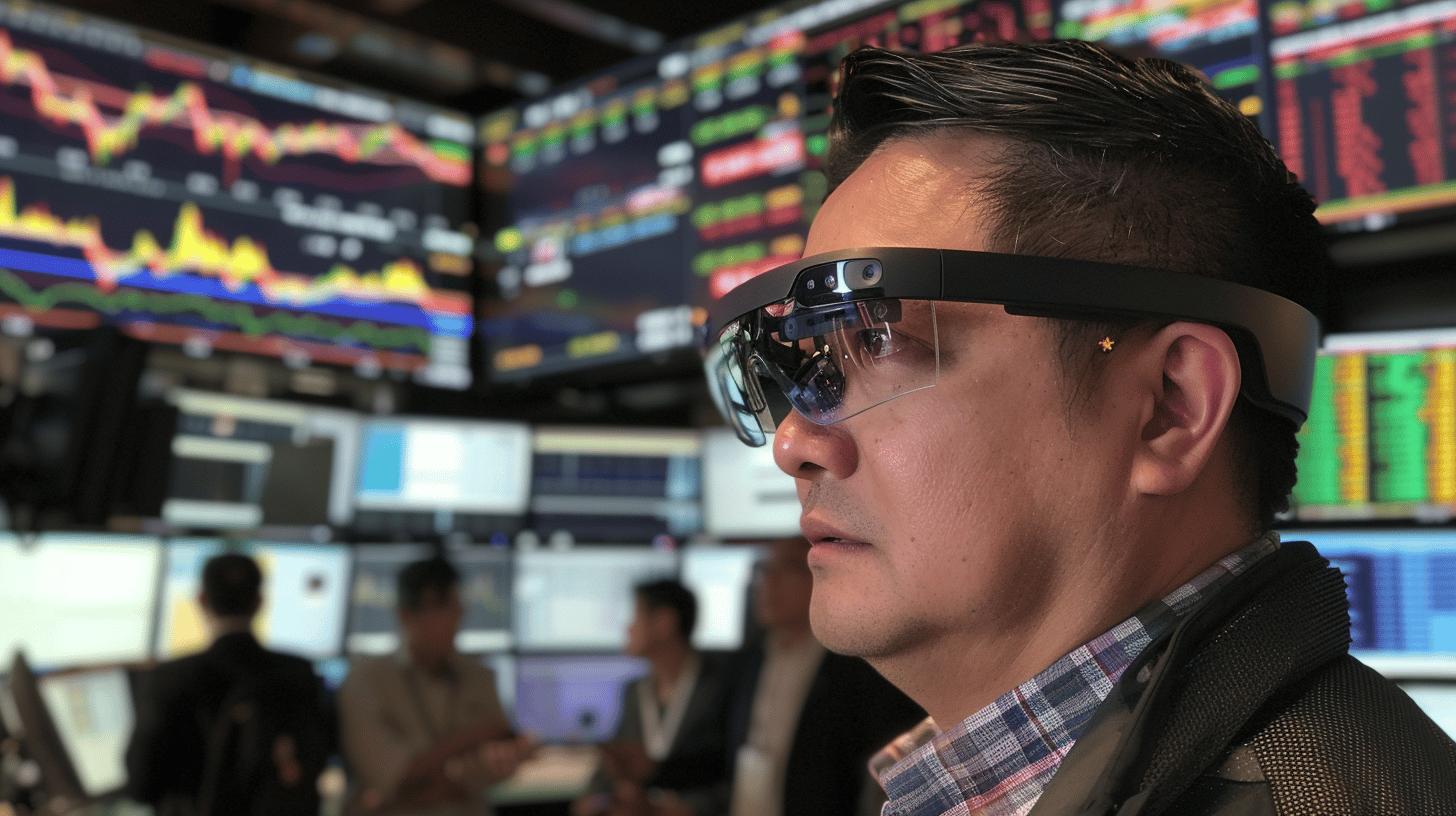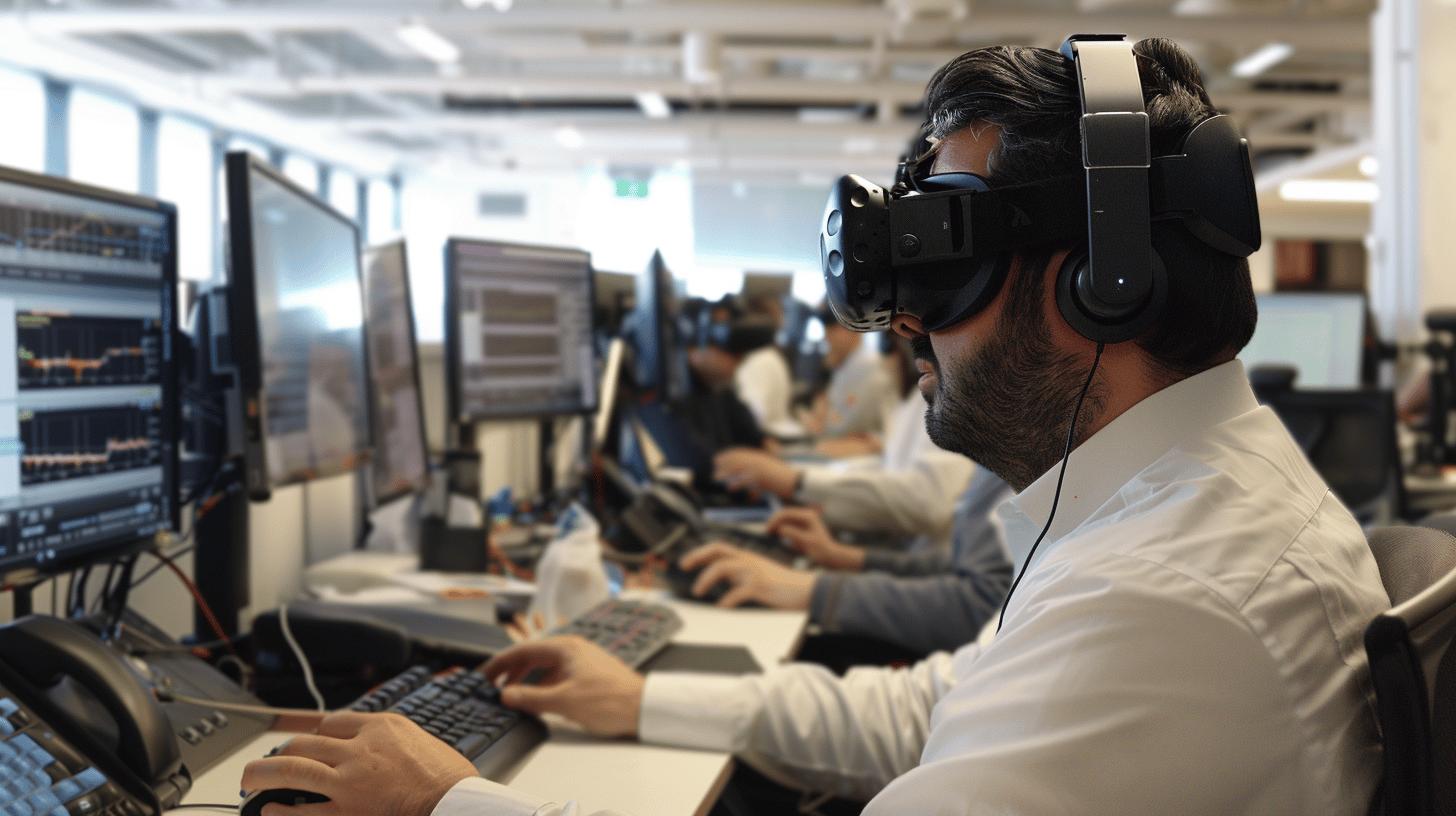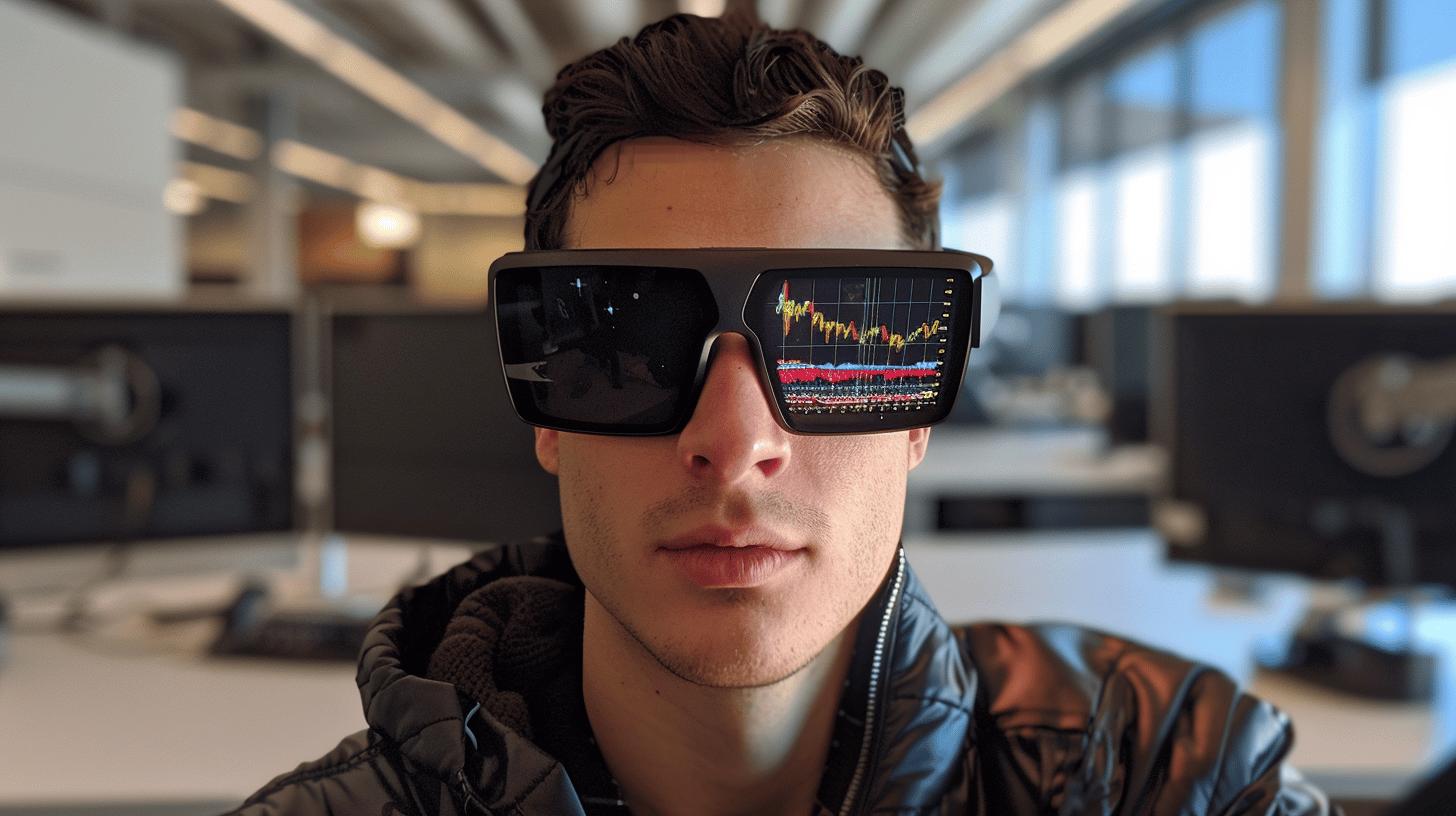Is augmented reality (AR) the next big thing in trading, or just another fleeting trend? As technology reshapes every corner of our lives, AR is making its mark on the financial arena, promising more immersive and interactive experiences for traders. Imagine having real-time market data, stock prices, and analytical insights overlaid onto your physical workspace. This isn't science fiction; it's a transformative leap in trading technology. Dive in to explore how AR trading is revolutionizing the financial landscape and why it might be the game-changer you've been waiting for.
Understanding AR Trading: An Overview
Augmented reality (AR) integrates digital information with the user's environment in real time, creating a composite view that enhances the user's perception of their surroundings. In technology, AR has found applications in various fields, from gaming and entertainment to education and healthcare. By superimposing digital content onto the physical world, AR provides users with an enriched experience that combines both virtual and real elements seamlessly.
In the trading sector, AR is applied by overlaying market data, stock prices, and trading analytics onto a trader's physical workspace. This integration allows traders to access real-time data without needing to switch between multiple screens or applications. For instance, AR can project stock charts, trading indicators, and news feeds directly onto a trader's desk or even onto wearable devices like AR glasses. This streamlined access to critical information aids traders in making quicker and more informed decisions.
- Real-time market data visualization
- Overlaying stock charts and indicators
- Enhanced trading analytics
- Interactive training simulations for new traders
- Integration with AI for predictive analytics
The transformative potential of AR in trading lies in its ability to create more immersive and interactive trading experiences. By reducing screen clutter and consolidating multiple data streams into a single AR interface, traders can focus better and improve their decision-making processes. Additionally, AR's interactive features enable traders to manipulate data visualizations and conduct in-depth analyses more intuitively. This evolution in trading technology promises to boost efficiency, accuracy, and overall performance in financial markets.
Benefits of AR Trading

Real-time data visualization in augmented reality (AR) trading allows traders to see market data superimposed in real time. This capability enables traders to access crucial information without the need to switch between multiple screens or applications. By overlaying stock prices, charts, and trading indicators directly onto their physical workspace, traders can quickly grasp market conditions and react promptly to changes. This seamless integration of real-world and digital data provides a comprehensive and intuitive trading environment.
Enhanced decision-making capabilities are another significant advantage of AR trading. With better data interpretation, traders can make more informed decisions. AR platforms often integrate artificial intelligence (AI) to support real-time applications through image and facial recognition capabilities. This synergy between AR and AI helps traders analyze patterns, predict market trends, and optimize their strategies. The improved visualization of complex data sets makes it easier for traders to identify profitable opportunities and mitigate risks.
AR trading also reduces screen clutter and streamlines information. Traditional trading setups often involve multiple monitors displaying various data streams, leading to a cluttered workspace. AR consolidates these data streams into a single, cohesive interface, allowing traders to focus on relevant information without distraction. By projecting essential data onto AR devices or physical surfaces, traders can organize their workspace more efficiently and maintain a clear view of critical metrics.
Improved trader efficiency and overall performance are notable benefits of AR trading. By streamlining trading operations and boosting productivity, AR enables traders to execute trades faster and with greater accuracy. The interactive nature of AR allows traders to manipulate data visualizations and conduct in-depth analyses more intuitively. This enhanced efficiency translates into better market performance and a competitive edge in the financial landscape.
| Benefit | Explanation |
|---|---|
| Real-Time Data Visualization | Allows traders to see market data superimposed in real-time. |
| Enhanced Decision-Making | Improves the ability to make informed trading decisions. |
| Reduced Screen Clutter | Consolidates multiple data streams into a single AR interface. |
| Improved Efficiency | Streamlines trading operations and boosts productivity. |
AR Trading Platforms and Tools
Various AR trading platforms and tools are currently being developed by leading tech companies and startups. These platforms integrate augmented reality with existing trading software to offer enhanced functionality and user experience. By overlaying digital information such as stock charts, trading indicators, and news feeds directly onto the user's physical workspace, these platforms provide traders with a seamless blend of real-time data and analytical tools. This integration helps traders make informed decisions more efficiently, leveraging the immersive nature of AR technology.
Examples of AR trading platforms include those developed by companies like Ticker Tape AR, TradingView AR, and Bloomberg AR Insights. Ticker Tape AR overlays real-time stock data and analytics onto physical surfaces, allowing traders to visualize market trends without switching screens. TradingView AR offers interactive charting tools and trading indicators through AR glasses, enhancing the analysis and trading process. Bloomberg AR Insights integrates news feeds and market analytics into an AR interface, providing comprehensive market insights accessible through wearable devices.
- Ticker Tape AR: Overlays real-time stock data and analytics onto physical surfaces.
- TradingView AR: Offers interactive charting tools and trading indicators through AR glasses.
- Bloomberg AR Insights: Integrates news feeds and market analytics into an AR interface.
- MetaTrader AR: Combines AR with its robust trading platform for enhanced visual analytics.
- ThinkOrSwim AR: Provides advanced trading tools and real-time data visualization in an AR environment.
The future potential and ongoing developments in AR trading tools are promising. With continuous advancements in AR technology, we can expect more sophisticated interfaces that offer even greater levels of interactivity and immersion. Future AR trading tools are likely to integrate more deeply with artificial intelligence, enabling predictive analytics and automated decision-making. Additionally, broader adoption of AR trading platforms across various financial markets will drive further innovation, making AR an integral part of the trading ecosystem.
Case Studies: AR Trading in Action

Case studies are crucial for understanding the practical applications and benefits of AR trading. They provide real-world examples that demonstrate how augmented reality can be effectively utilized in the financial sector. By examining these case studies, we can gain insights into the specific innovations and improvements that AR brings to trading operations.
One notable case study involves a large financial firm that implemented AR overlays to enhance trading efficiency. By integrating AR into their trading systems, the firm was able to project real-time market data, stock prices, and analytics directly onto traders' desks. This approach minimized the need for multiple screens and streamlined the decision-making process. The result was a significant increase in trading speed and accuracy, allowing traders to respond more swiftly to market changes.
Another key case study highlights the adoption of AR in training programs for new traders. Financial institutions have started using AR to create interactive training simulations that mimic real-world trading environments. These simulations offer a hands-on learning experience, enabling trainees to practice trading strategies and analyze market data in a controlled setting. The use of AR in training has led to improved learning outcomes and better preparedness among new traders, ultimately enhancing their performance once they transition to live trading.
Lastly, a case study focusing on market analysis demonstrates the benefits of AR tools for better market visualization. By utilizing AR, analysts can overlay complex data sets and trading indicators onto physical surfaces, facilitating a more intuitive understanding of market trends. This enhanced visualization capability has resulted in significant improvements in analysis accuracy, enabling analysts to make more informed predictions and recommendations.
| Case Study | Description | Results |
|---|---|---|
| Financial Firm | Enhanced trading efficiency using AR overlays. | Increased trading speed and accuracy. |
| Training New Traders | Adoption of AR in training programs. | Improved learning outcomes and trader readiness. |
| Market Analysis | AR tools for better market visualization. | Significant improvements in analysis accuracy. |
Future Trends in AR Trading
The future of AR trading looks incredibly promising, driven by continuous advancements in augmented reality technologies. Ongoing innovations are leading to more sophisticated AR interfaces that offer enhanced user experiences and greater interactivity. These advancements are not only improving the efficiency of trading platforms but also making them more intuitive and accessible. As AR technology evolves, we can expect trading systems to become more immersive, providing traders with a seamless blend of the physical and digital worlds.
One of the key predictions for the future of AR trading is the integration of artificial intelligence (AI) for predictive analytics. This combination has the potential to revolutionize trading by providing more accurate market predictions and automated decision-making capabilities. AI algorithms can analyze vast amounts of data in real-time, identifying patterns and trends that may not be immediately apparent to human traders. When integrated with AR, these predictive analytics can be visualized in an intuitive manner, allowing traders to make better-informed decisions quickly. This synergy between AR and AI is expected to drive significant improvements in trading strategies and outcomes.
- More sophisticated AR interfaces
- Integration with AI for predictive analytics
- Broader adoption across financial markets
- Increased innovation driven by major tech companies like Apple
The broader adoption of AR trading in various financial markets is another trend to watch. As more financial institutions recognize the benefits of AR, the technology is likely to become a standard tool in the trading industry. Companies like Apple entering the AR market are expected to drive further innovation, making AR solutions more accessible and effective. This widespread adoption will not only enhance the trading experience but also set new benchmarks for efficiency and accuracy in financial markets. The future of AR trading is set to transform the financial landscape, offering unprecedented opportunities for traders and investors alike.
Final Words
In the action, we explored the fundamentals of AR trading and its substantial benefits. We delved into the transformative potential of augmented reality in overlaying vital trading data for enhanced decision-making. Various platforms and tools further solidified the advancements in AR trading, showcasing real-time applications and improved efficiency.
With compelling case studies and insights into future trends, AR trading promises a progressive direction. As AR technologies evolve, traders can expect more sophisticated interfaces and broader market adoption. Embracing AR trading can offer significant advantages, paving the way for a more immersive and efficient trading environment.
FAQ
What is AR trading?
AR trading integrates augmented reality technology with trading activities by overlaying digital information such as market data, stock prices, and trading analytics onto physical workspaces.
How does augmented reality apply to trading?
Augmented reality in trading overlays real-time market data, stock prices, and trading analytics onto a trader's physical workspace, enhancing data visualization and decision-making.
What are the benefits of AR trading?
AR trading offers real-time data visualization, enhanced decision-making, reduced screen clutter, and improved trader efficiency, leading to increased productivity and streamlined operations.
Can you give examples of AR trading platforms and tools?
Various AR trading platforms overlay stock charts, trading indicators, and news feeds. Key examples include platforms developed by leading tech companies and startups, integrating AR with existing trading software.
How has AR trading been successfully implemented?
Case studies show financial firms enhancing trading efficiency with AR, using AR in training programs to improve learning outcomes, and applying AR tools for better market visualization, resulting in improved trading performance.
What future trends are expected in AR trading?
The future of AR trading includes more sophisticated interfaces, AI integration for predictive analytics, and broader adoption across financial markets. Key trends include expanded AR applications and innovations driven by major tech players like Apple.
Is A.R. Trading Company Limited based in Hong Kong?
Yes, A.R. Trading Company Limited is a company based in Hong Kong.
